Video-recording of Anthony Philip Heinrich (1781-1861), Works for Organ Solo (comp. 1850-51).
Anthony Philip Heinrich (1781-1861): Works for Organ Solo. As part of the research program Four American Originals for the Organ: Anthony Philip Heinrich, Charles E. Ives, John Cage, Jerome N. Margolis.
A project by Aloma Bardi; a collaboration of ICAMus with Centro Studi Musicali Ferruccio Busoni & Collegiata Sant’Andrea, Empoli, Italy.
Première video-recording.
Lucia Baldacci, organist; Lorenzo Ancillotti, organ advisor & registrant; Organ Bevilacqua-Chichi 1964-2004. Live recording, Collegiata Sant’Andrea, Empoli, Italy, October 25, 2021.
Introductory Notes by Aloma Bardi.
Video by Matteo Picardi & Marco Stefano Innocenti. Duration: 31:16.
Photos by Sanzio Fusconi.
Sunday, December 5, 2021: publication of video on our channels.
In the image below: The organ of the Collegiata di Sant’Andrea, Empoli, Italy; Organ Bevilacqua-Chichi 1964-2004; photo by Sanzio Fusconi.
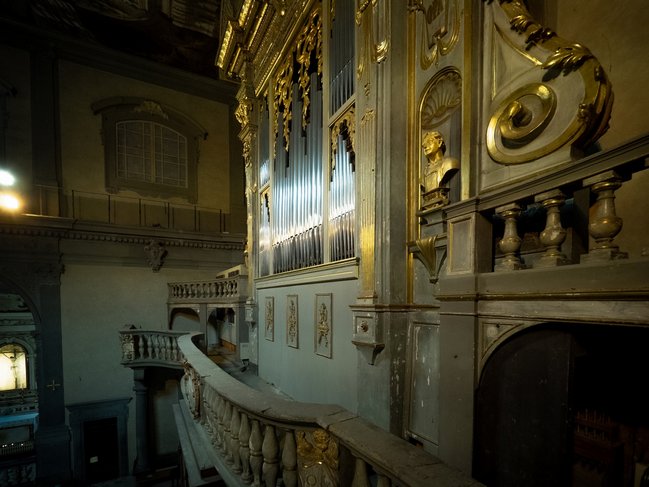
INTRODUCTORY NOTES by ALOMA BARDI
ANTHONY PHILIP HEINRICH (1781-1861)
Heinrich was a Bohemian-born American Romantic composer, and a prominent figure in the international musical world. In the 1840s and 1850s, festivals on a grand scale were devoted to his music in New York, Boston, Philadelphia. He was also well known in Europe, where his remarkably original music was performed in London, Dresden, Prague, Graz. Hundreds of his minor works for piano solo or accompanied voice were published in America during his lifetime, but all his larger scores remained unpublished.
In 1916, music librarian, scholar and composer Oscar G. T. Sonneck (1873-1928) at the time Head of the newly formed Music Division at the Library of Congress in Washington, D.C., acquired the “Musical Estate of Anthony Philip Heinrich,” an outstanding Collection of holograph manuscripts, published scores and documents.
The vast Heinrich Collection housed at the Library of Congress Music Division contains unconventional orchestral works inspired by European composers such as Beethoven and Mendelssohn, as well as the American wilderness and the Native Americans. Heinrich’s scores are still challenging today on account of their magnitude, style, and instrumentation. For years, ICAMus has been committed to their rediscovery.
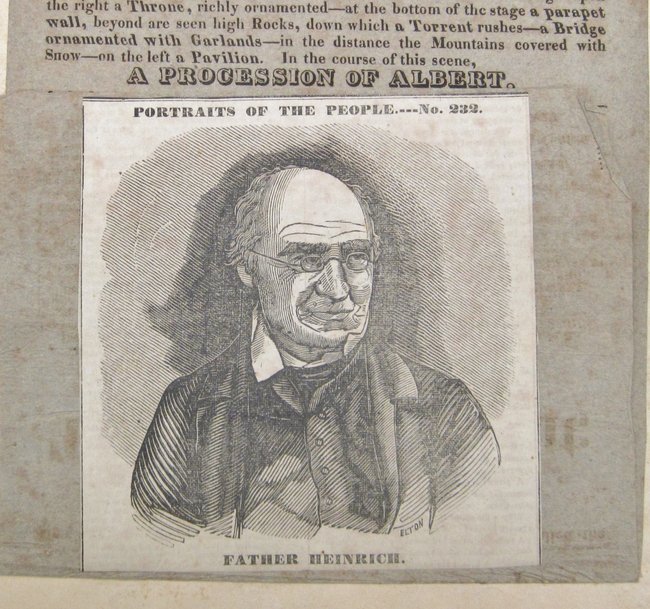
In the image above: Anthony Philip Heinrich’s portrait. Cut-out etching included by the composer in his monumental collection of scores and miscellany documents known as Scrap Book (p. 1196; Heinrich Collection, The Library of Congress Music Division). Heinrich glued the etching to the program of his own melo-drama, The Child of the Mountain: Or, The Deserted Mother (Philadelphia, April 7, 1821). Photo by Aloma Bardi, 2014; courtesy The Library of Congress Music Division.
HEINRICH’S WORKS FOR ORGAN SOLO
In the large corpus of works by Heinrich, there are three compositions for organ solo: Voluntary, Elegy, and Phantasy. The organ is included in the scores of numerous other works by Heinrich, however in those cases it is either an alternative to the piano, or an accompanying instrument.
The manuscript of the three organ compositions by Heinrich is part of a bound collection entitled Musical Memorandums, dating from 1850-51. They appear to have been written in the same year. The three works remained unpublished until 1996 (Kallisti Music Press, Philadelphia; Andrew Stiller, editor).
The style is complex and makes use of bold harmonies. Heinrich’s three compositions show an experimental approach to organ music. The organ had been common in North America since the Colonial Era, but many original American compositions for the organ had not yet been produced; performance remained long mostly improvisation, at the service of religious worship, unless European music was played.
The Romantic improvisational character of Heinrich’s organ works features a concise, undetailed writing, leaving pedals and stops to the performer’s imagination and decision (“Pedals & Stops a Gusto”; “Stops & Pedals a Piacere”; “Stops and Pedals ad Libitum”). The three compositions reveal Heinrich’s personal exploration of expressive and technical potential for the development of American organ music.
In the image below: Organist Lucia Baldacci standing by the beautiful instrument of the Collegiata di Sant’Andrea, Empoli, Italy, during a rehearsal of the Heinrich program for ICAMus, October 2021; Organ Bevilacqua-Chichi 1964-2004; photo by Sanzio Fusconi.
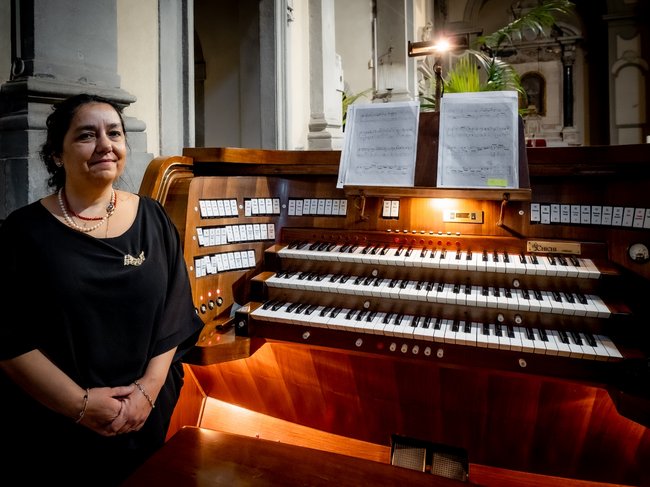
ANTHONY PHILIP HEINRICH, VOLUNTARY FOR THE ORGAN. Larghetto-Andantino con moto. Comp. ca. 1850-51.
A voluntary is a music composition that is often free in style, with an improvisatory character. Heinrich’s Voluntary for the organ is a rewriting and expansion of a previously composed piece, dating from 1837, based on Händel’s Verdi prati from the opera Alcina. The final result, that Heinrich in an explanatory note on the manuscript refers to as a “Fantasia,” bears little resemblance both to the original Händel inspiration and to the previous Heinrich piece. The Voluntary for the organ implies a classic, epic and non sacred reference in its composition history, which exemplifies the freedom typical of Heinrich in treating his musical material, and his repurposed use of existing music within a totally different context.
ANTHONY PHILIP HEINRICH, ELEGY FOR THE ORGAN. Grave. Comp. ca. 1850-51.
Except for the introduction and coda, the Elegy, with its distinctive melodic material, is based on Heinrich’s own Ode to the Memory of Commodore O.H. Perry: Marcia funerale for voice and piano (Philadelphia: Bacon & Hart, & by the Author, Kentucky, 1820), setting a memorial-patriotic poem by Philadelphia poet and printer H.C. Lewis; the 1820 score of the Ode was followed and summarized by an Epitome for the piano forte and also for the violin and flute. Oliver Hazard Perry was an American naval commander who had died in 1819. The composition was part of a Heinrich collection, The funeral strains. Heinrich constantly reworked his own musical ideas and manuscripts, transforming them into surprisingly new pieces.
ANTHONY PHILIP HEINRICH, PHANTASY FOR THE ORGAN. Grave. Comp. ca. 1850-51.
The Phantasy may have originated from the first four notes of the Voluntary. Heinrich commonly practiced self-quotation and elaboration of existing music, both his own and by other composers, which makes compiling a chronology and catalogue of his works a particularly complex and challenging task. The initial melodic quality of the piece progressively rarifies and multiplies in its increasing use of chromaticisms and in its free ranging, improvisatory style. It is the longest of the three organ pieces (13 pages in the printed edition) and reveals a Romantic approach to the composition, treated with unconventional fluidity. Heinrich’s Phantasy for the organ takes both the performer and the listener along a journey of inventiveness and visionary freedom.
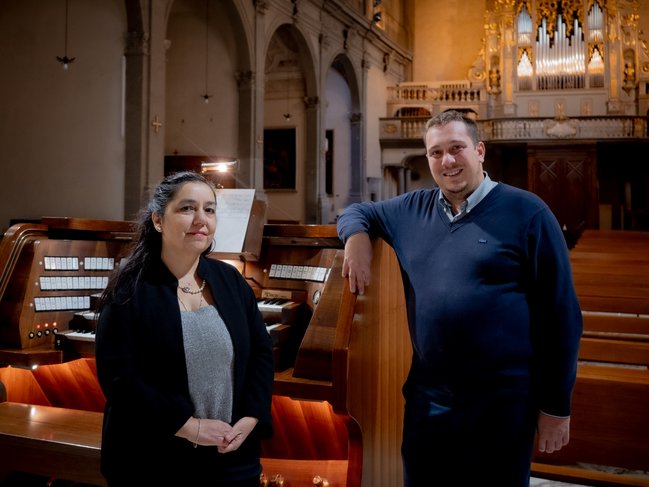
In the photo above: Organist Lucia Baldacci with Lorenzo Ancillotti, Director of Centro Studi Musicali Ferruccio Busoni, organ advisor and registrant, during the live recording session of the Heinrich program for ICAmus, October 25, 2021; Organ Bevilacqua-Chichi 1964-2004. Photo by Sanzio Fusconi.
ACKNOWLEDGMENTS
Lorenzo Ancillotti
Lucia Baldacci
Aloma Bardi
Gabriele Boccaccini
Barbara Boganini
Centro Studi Musicali Ferruccio Busoni
Collegiata di Sant’Andrea, Empoli
Sanzio Fusconi
Marco Stefano Innocenti
Kallisti Music Press
The Library of Congress Music Division
Matteo Picardi
Chiara Sintoni
Paolo Somigli
Andrew Stiller
In the image below: The organ of the Collegiata di Sant’Andrea, Empoli, Italy; Organ Bevilacqua-Chichi 1964-2004; photo by Sanzio Fusconi.
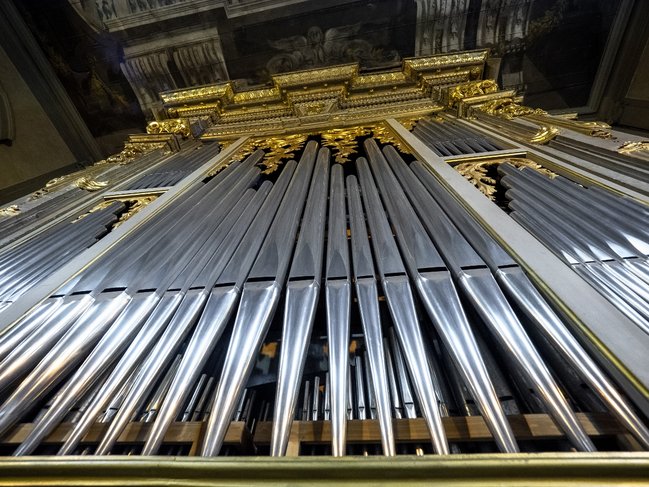
For Peter Herbert
Researcher, Historical Detective, A.Ph. Heinrich Scholar, and Friend
Whose passionate investigation of this composer has inspired our work.
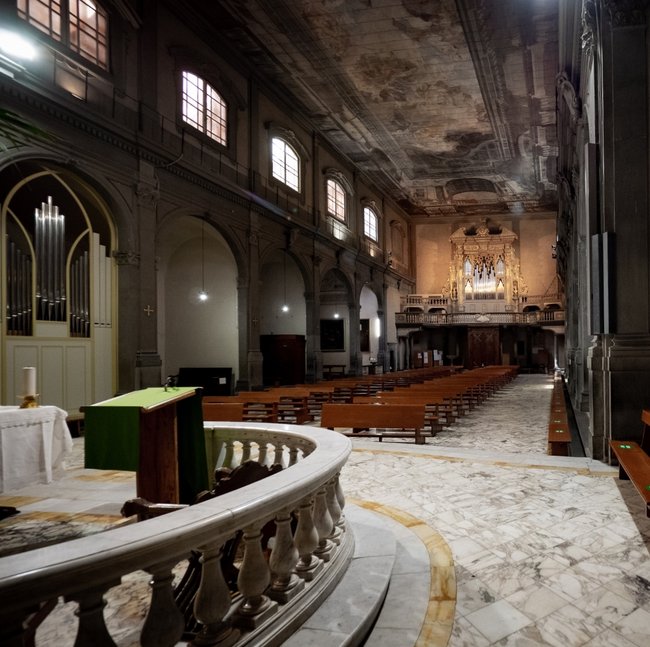
In the image above: Interior of the Collegiata di Sant’Andrea, Empoli, Italy, were we recorded the Heinrich program for ICAMus; Organ Bevilacqua-Chichi 1964-2004; photo by Sanzio Fusconi.
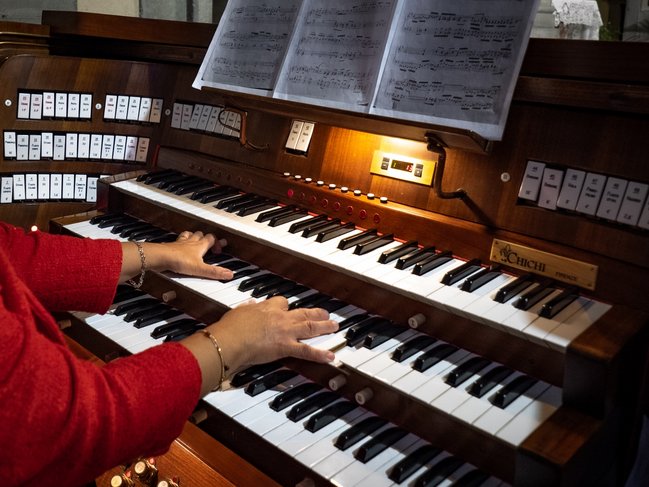
In the image above: Organist Lucia Baldacci rehearsing the Heinrich program for ICAMus on the beautiful instrument of the Collegiata di Sant’Andrea, Empoli, Italy, October 2021; Organ Bevilacqua-Chichi 1964-2004; photo by Sanzio Fusconi.

